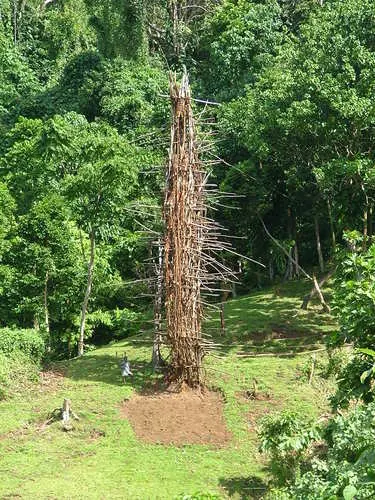The origins of bungee jumping stem from an incredible ritual that takes place on Pentecost Island. The villagers who reside on the island are responsible for inventing the precursor to modern day bungee jumping, a ritual they refer to as "Naghol" or "land diving." At one point, these villagers even sought out royalties from bungee jumping firms and clubs supposedly using their stolen idea.

Men and young boys come together from various Vanuatu villages and dive from towers similar to the one pictured above. The reason for this is embedded in an old legend that tells of a woman who wanted nothing more to do with her husband, named Tamalie, supposedly because he was too aggressive with his sexual desires. As the story goes, Tamalie's wife took to the forest in an effort to escape her husband and climbed up a Banyan tree. The disgruntled husband followed, so she attached Lianas, a type of woody vine, around her ankles and leaped from the tree. Tamalie jumped after her but did nothing to suppress the fatal impact that followed his descent. The original land diving ritual was performed so that men in the villages would not be tricked again, but its meaning has evolved over time.
Young boys who wish to pass the test of masculinity and become a man in the eyes of their community must make the dive. Taking part in this ritual is considered an act of boldness, which is associated with being a warrior. Anyone who does not participate in the ritual or backs out will not be looked down upon by their peers; performing the dive merely provides them with a future opportunity to prove their masculinity.

This ritual has more to it than just testosterone-filled themes. Land diving is performed every year during the months of May, June or July, and successful dives are said to help ensure a bountiful yam harvest. The wet season that follows shortly after the yam harvest brings about many illnesses and physiological problems. Vanuatu villagers believe that proper dives help prevent these ailments and increase the strength, health and overall vitality of the divers.
New towers are constructed ever year. They take at least two weeks to construct, and only freshly cut wood is used so the tower is not easily compromised. Towers are designed to represent a human body and feature a proverbial heads, shoulders, bellies, breasts, genitals and knees. Multiple diving platforms meant to symbolize penises are placed on the tower, with heights ranging from 10 to 33 meters. A strut located beneath each platform is meant to represent a vagina.
During any given ritual, between 10 and 20 men and boys will perform a Naghol without any safety equipment whatsoever. Even lucky charms are prohibited. Divers use only two tree vines attached around their ankles as a make-shift bungee cord. Vines are split at the ends so they can be properly attached. Established elders choose the vines to be used during a ritual; the vines must be flexible, of perfect length, and full of sap for the dive to be considered safe by the villagers' standards.
Participants jump in the order of least to most experienced, with inexperienced divers typically jumping from the lower platforms. Before making their leaps of faith, divers have the opportunity to perform by singing songs, giving speeches or making pantomimes. As divers reach the end of their descent, the Lianas will cause the jumping platform to "snap" back, producing a very loud noise. This helps to absorb a portion of the impact that results from the fall, which can reach up to 45 miles per hour. Since the vines are not very elastic, divers don't bounce back up, but instead find themselves swinging very slightly after the vine has stretched to its limit. If all goes well, the hair of the diver will brush against the ground, which is said to fertilize the soil. The Guinness World Records states that the g-force participants experience at the end of their dive is the greatest felt by humans in the non-industrialized world.
Participants who wish to participate in the ritual spend the night before their jump below the tower to keep evil spirits away. Women are not permitted to dive, but play an important role by performing choreographed dances and singing traditional chants at the bottom of the tower as a way to encourage divers - especially the inexperienced ones. Some are as young as five years old. It is important that this ritual only be performed during the aforementioned times of the year due to seasonal effects on the tree vines. Queen Elizabeth II learned this through a firsthand experience.

Despite the incredible dangers associated with land diving, only two fatalities have been recorded as of yet. One of these fatalities occurred in 1974 because of an off-season jump that only took place after the villagers were convinced by the British colonial administration to put on a show for Queen Elizabeth II, Prince Philip and other important guests. Since it was the wet season, the vines were not elastic enough for their destined purpose. This fact did not quell the divers' boldness, so the ritual went on in spite of the clear danger. One unfortunate diver met with a cruel fate when his Lianas could not withstand the force of his descent. With a broken back at the very least, the injured villager was taken to a hospital where his wounds proved fatal.
Remarkably, the only other death reported from this ritual occurred when a diver broke his spine during a bad landing. This fact may provide some reassurance to anyone who is hesitant about trying modern day bungee jumping, which has an insignificant mortality rate. We have the boldness of the Vanuatu villagers to thank for the extreme sport that we now know as bungee jumping. Some day they just might receive their royalty check.